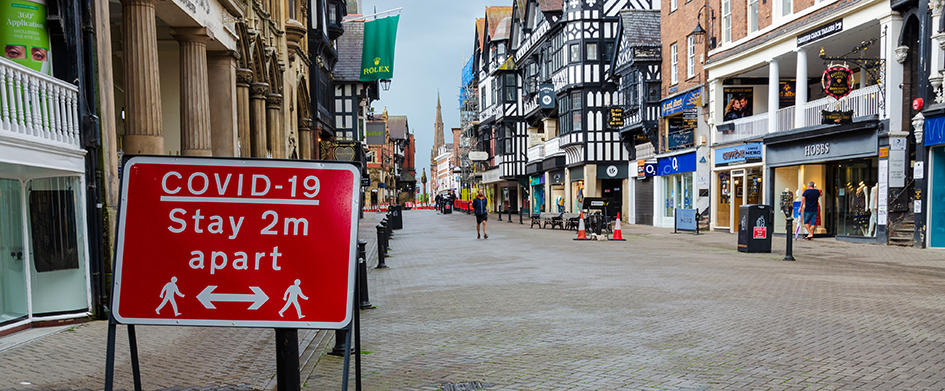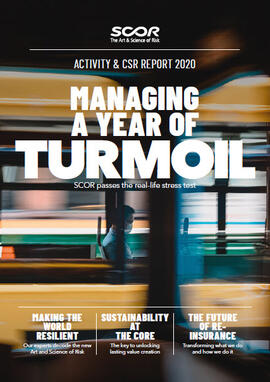Managing risk in the context of the Covid-19 pandemic
“The crisis has highlighted even more strongly the extreme complexity and interconnectedness of risks”
2 juin 2021
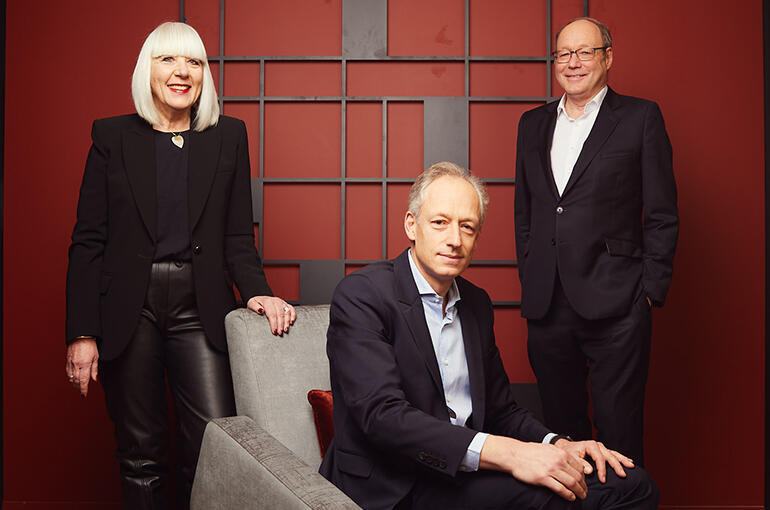
The Covid-19 crisis has heightened general awareness of the uncertainties that can rule our lives. It is the job of SCOR’s experts to develop in-depth knowledge of these uncertainties, so that they can help people and society to prepare and – when crisis strikes – recover.
Wayne Ratcliffe, Head of Risk Governance, Bruno Latourrette, Chief Knowledge Officer at SCOR Global Life, and Anne-Marie Cical, Regional Chief Underwriting Officer Europe at SCOR Global P&C, discuss risk management, modeling and the Covid-19 pandemic.
How do you manage risk in a context like the Covid-19 pandemic?
Wayne Ratcliffe, Head of Risk Governance — As reinsurers, we try to spread the risks we take. In today’s world, there are more and more risks and they’re becoming increasingly interconnected, which makes the job of risk managers more challenging. The Covid crisis is a good example. Many people didn’t foresee the potential ramifications and interconnections of the pandemic. Reinsurers need to be able to put a price tag on risks, to charge for insuring against them. We need to estimate how much it will cost before the event occurs. That’s not an easy job. It takes a whole group of experts – actuaries, doctors, specialists, underwriters – to be able to do it.
How does that work, in practical terms?
W.R.— We look at past experience. For a pandemic, for instance, we look at all the pandemics that have occurred in the past. Then we try to estimate the frequency of such events and how lethal each would be if it were to happen again. We also have to adjust for things like medical advances, increased air travel and non-pharmaceutical interventions like lockdowns and masks. All of these things are built into our models. We replicate them in a way that reproduces the frequency of the event, its severity and the probability of it happening now or in the future. Every time there is a big event, we learn and we adjust, recalibrating our models if necessary. It’s a continual dynamic process.
Bruno Latourrette, Chief Knowledge Officer at SCOR Global Life — As Wayne mentioned, before Covid-19 we had models that allowed us to predict the occurrence of a pandemic in the future and estimate its severity from a risk management perspective. But we didn’t have a model to assess, when a pandemic occurs, how it would develop, so we have had to create new ones. We have used new technology to develop a state-of-the-art SEIR model, the gold standard for epidemiological models, for which we enhanced and improved an open-source algorithm.

“ONE THING IS CLEAR:
THE PANDEMIC IS IMPACTING
THE LOWER SOCIOECONOMIC CLASS DISPROPORTIONATELY.
IT IS UNFORTUNATE, BUT IT’S A REALITY.”
Bruno Latourrette,
Chief Knowledge Officer at SCOR Global Life
What are footprint scenarios?
W.R.— Models are necessary, but they’re not sufficient by themselves. There are things that can’t easily be captured in a model. We need “what if” scenarios as well. One of the techniques we use is what we call a footprint scenario. We take a historic event – for example it could be an earthquake in the 1600s in China or a tsunami off the West Coast of North America in 1700. We look at these events and we replicate them in today’s portfolio to see how much they would cost. Then we overlay our own protections because we, as a reinsurer, are also protected against extreme events. And we ask, is this plausible? Should we be worried about it? Should we make some changes to our exposure? Should we buy more protection?
These are historical footprints, but possibly even more important are what I call “imagined footprints”, and even “imagined combined footprints” – things that are all happening at the same time because of the interconnection of risks. This is where the art of risk comes in. It’s about imagining things. They have to stay within the realms of possibility, of course. They can’t be completely crazy. But if we don’t do this, people will ask: why didn’t you think of that? Hasn’t it happened in the past? We’ve incorporated pandemic risk in our modeling using data from the past, and we’ve also imagined scenarios based on historical information about past pandemics.
"One big, unexpected consequence of the Covid-19 crisis has been Business Interruption"
Aside from modeling, how did you build knowledge on Covid?
B.L. — SCOR has a lot of in-house expertise. We have epidemiologists, medical doctors, actuaries, data scientists, data engineers and behavioral specialists in 35 locations across the globe. Collaboration and connection are very important for us as they enable us to learn from each other. As an example, at the very early stages of the pandemic, we built networks of people across all our locations to monitor what was happening in each spot and to learn from the countries that were at advanced stages, such as China, South Korea and Italy. We also built a working group to address all aspects of the pandemic, from infection rates, lethality, the impact on morbidity and testing strategies to, for example, the impact of lockdowns on the diagnosis and treatment of cancer. We also leveraged the large networks of external experts with whom we work on an ongoing basis, as well as new experts who specialize in Covid-19, to understand critical things like vaccination protocols.
As another example, the SCOR Foundation for Science supported a paper on Covid-19 genetics that was published in Science magazine. This knowledge was shared internally at SCOR as well as externally with our clients, which allowed us to be very proactive in terms of adapting our pricing and medical underwriting approach. We issue a medical memo, which is updated regularly as the information moves very fast. We also help our clients to assess the impact of Covid-19 on their own portfolios.
How do the models figure into SCOR’s capital management?
W.R. — The most important thing from a capital management point of view is to continually monitor our solvency – in other words, the amount of capital we have available compared to the capital we’re going to need. When interest rates are low, it can lower our capital. On the other hand, the capital required can increase when we discount future cash flows. Some extreme events are far in the future. In those numbers, the required capital is much higher and the solvency ratio goes down.
What impact has the Covid-19 crisis had on SCOR’s portfolio?
Anne-Marie Cical, Regional Chief Underwriting Officer Europe at SCOR Global P&C — On the P&C side, the impact has been to some extent quite unexpected. As both Wayne and Bruno have pointed out, pandemic risk has always been on the radar of the insurance sector, but it was mainly seen as a Life catastrophe risk. The government responses to prevent the propagation of the disease and the economic consequences of the crisis were underestimated by our sector. No one would have imagined a global lockdown with a major impact on Business Interruption, among other impacted lines of business (Credit & Surety, Event Cancellation, etc.).
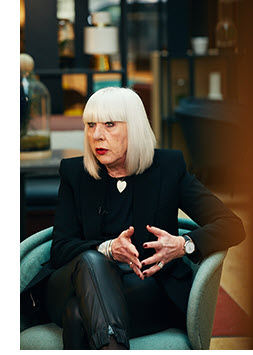
“ONE OF THE MOST CRUCIAL LESSONS WE HAVE LEARNED
IS THAT WE NEED TO ENSURE
THAT OUR CONTRACTS REFLECT THE
INTENTION OF THE COVER,
SO AS NOT TO FIND OURSELVES TAKEN BY SURPRISE.”
Anne-Marie Cical,
Regional Chief Underwriting Officer Europe at SCOR Global P&C
Has this crisis revealed any other risks?
W.R. — We know that the risk universe is expanding – becoming more complex and more interconnected. For example, climate change carries risks far more significant than what we’re living through at the moment. We haven’t yet understood all the potential ramifications of climate change and how they can interact with risks like a pandemic. We know, for instance, that deforestation is changing ecosystems, creating situations where humans are much closer to wild areas, wild animals. This could increase the possibility of novel viruses becoming more transmissible, which could in turn increase the risk of pandemics in the future.
There’s also global warming. Imagine a situation where some tropical viruses move further north and human migrants move away from uninhabitable areas, say in Africa. The combination of new viruses with a larger population, particularly in Europe, could create conditions where pandemics are more frequent and possibly even more lethal. Other aspects of global warming are even more complicated. The ocean currents are slowing down because large icebergs in polar regions are melting and as a result there is less salt in the sea. This causes the nutrients in the oceans to move around more slowly, which means aquatic animals and fish are having more difficulty finding food. And then there are plastics and pollution. All of this could impact the food chain for humans.
What are the unexpected consequences of Covid-19?
A-M.C. — As I said, one big, unexpected consequence of the Covid-19 crisis has been Business Interruption, which is traditionally triggered by physical damage. For example, a fire burns everything to the ground and the business has to close. It takes a lot of time to repair things before you can open again. In the case of Covid-19, businesses have had to close because of lockdowns or curfews, without any prior physical damage. Contract certainty has become a major issue. Some Non-Physical-Damage Business Interruption covers have been developed – mostly in European markets – with the intention of covering so-called on-premises risks, such as denial of access or administrative closures following the outbreak of an infectious disease (e.g., salmonella, legionella) in a specific location. In a lot of cases the wording has been considered vague or ambiguous, lending itself to interpretation.
Cases are being brought to court. The decisions depend on the judge’s reading of the wording and it takes a lot of time to decide. Likewise with Business Interruption: it is complex to evaluate the loss as the compensation amount is linked to both the appreciation of the loss over a full fiscal year and the capacity of the insured to restart its business. Insurers had no intention of delivering cover in a pandemic situation, mainly because they didn’t anticipate a global lockdown.
On the reinsurance side, we address natural perils, conflagration, terrorism, and social unrest as catastrophe risks. Now we are finding that we must handle potential claims with wording for which the contract was not initially designed.
Is pandemic risk uninsurable?
A-M.C. — Pandemics are considered by the insurance community as hardly insurable or even uninsurable. Why? Because the principle of insurance is based on risk pooling and diversification (in terms of space and time). When the economy is collapsing everywhere, you cannot address the issue.
None of the many ongoing initiatives on how to address this risk have led to a solution so far. To what extent public-private partnerships could be implemented remains an open question. The French Minister of Finance, after having called for an extensive study involving all insurers, reinsurers and associated stakeholders, has finally decided not to pursue an insurance solution that would acknowledge private capacity constraints. The amount at stake is so huge that, based on current estimates, the capitalization of the insurance sector is nowhere near sufficient to cover the total cost of a pandemic.
SCOR has always been aware of the risk of a pandemic and has identified it as one of the biggest exposures, but mainly impacting the Life side. On the P&C side, we have been cautious not to overexpose lines of business which might add risks (e.g., Event Cancellation). Since the advent of the Covid-19 crisis, we have been working on our guidelines, pulling together our legal, underwriting and risk management teams in order to clearly exclude pandemic risk as far as property lines are concerned. We have warned our clients that pandemic risk does not fit with our risk appetite, as we can only write risks we can assess, measure and price.
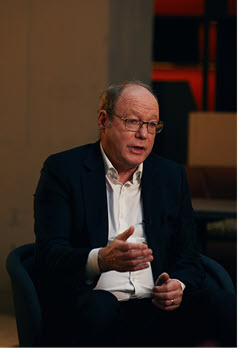
“THIS IS WHAT RISK MANAGEMENT IS ALL ABOUT.
WE LOOK AT THE BAD THINGS THAT COULD HAPPEN
SO THAT WE CAN TRY TO MANAGE THEM
BEFORE THEY ACCELERATE.”
Wayne Ratcliffe,
Head of Risk Governance
Has the crisis changed how you view things?
W.R. — We have to have a certain amount of humility in risk management. Perhaps we didn’t imagine all of the economic repercussions of this pandemic. So yes, we’ve learned from that. We can’t always get it right. The two main risks of this crisis are the health and the economic risks. The economic risks have created tremendous stress for companies and sectors that may not, unfortunately, survive. One could argue that the pandemic has just been an accelerator of the natural decline of certain sectors.
Even so, this will inevitably have impacts for insurers. Presumably these sectors will be replaced by others – this is the natural flow of the economy. Central banks and governments have tried to absorb or help reduce the impact of the pandemic by injecting trillions of dollars into the various economies, as well as through interest rate management. We have to manage the solvency ratio and make sure it stays within reasonable limits.
What was the impact on the P&C renewals?
A-M.C. — In previous years, the discussions were mostly centered around price. During the last renewals, by contrast, the main issue was contract wording. We needed to clarify that we have no intention of covering pandemic exposure, by introducing proper exclusion clauses in all property lines. A you can imagine, the pressure on P&C reinsurers’ results also led to a price increase dynamic.
What have you learned from the crisis?
 W.R. — There are so many things that we have all learned from this pandemic – insurers, governments, economic agents, the general public. There are enormous social and political implications and we still don’t know how this will pan out in the long term.
W.R. — There are so many things that we have all learned from this pandemic – insurers, governments, economic agents, the general public. There are enormous social and political implications and we still don’t know how this will pan out in the long term.
B.L. — One thing is clear: the pandemic is impacting the lower socioeconomic class disproportionately. It’s unfortunate, but it’s a reality.
W.R. — It’s true, the pandemic has really put inequalities into focus; some people have suffered a lot more than others and we need to take that on board, to think about what we should be doing. If we don’t, social tensions can lead to political instability. We also see geopolitical tensions between countries trying to blame one another. All of this will need to be managed.
From a reinsurance point of view, the crisis has highlighted even more strongly the extreme complexity and interconnectedness of risks. Covid is just one example and there are going to be many more in the future. We know that cyber-risks and climate change are real, but there are a whole host of economic interactions that didn’t exist before. Technology is moving fast. This means that the need to protect against these risks is going to increase – people and companies will need protection.
B.L. — To my mind, the crisis has confirmed that what we’ve been doing over the past two to three years is on the right track. There has been a fantastic acceleration in the use of technology, and we are fortunate that we were ready for that from the outset. The pandemic has also been a formidable accelerator for building community and sharing knowledge.
A-M.C. — On the P&C side, contracts need to be clear and not subject to interpretation. “Wording precision and consistency” is the new motto.
The event is still ongoing, and we have no idea how long the virus will be circulating. Of course, we have a lot of hope with the vaccines, but as we are still in the middle of the “storm”, it will take time to appreciate the full extent of the pandemic.
This interview is taken from the Annual report 2020.
